Lenses
Class 10-Science & Technology Part-1-Chapter-7- Maharashtra Board syllabus
Solution
Question 1:
Match the columns in the following table and explain them.
| Column 1 | Column 2 | Column 3 |
| Farsightedness | Nearby object can be seen clearly | Bifocal lens |
| Presbyopia | Far away object can be seen clearly | Concave lens |
| Nearsightedness | Problem of old age | Concave lens |
Farsightedness: This defect is also known as Hypermetropia. In this defect the human eye can see distant objects clearly but cannot see nearby objects distinctly. It is caused due to Since a convex lens has the ability to converge incoming rays, it can be used to correct this defect of vision by using a convex lens with proper focal length. This lens converges the incident rays before they reach the lens. The lens then converges them to form the image on the retina. Presbyopia: This is a common defect of vision, which generally occurs at old age. A person suffering from this type of defect of vision cannot see nearby objects clearly and distinctively without spectacles. Presbyopia is caused by the It can be corrected using bifocal lens. In such lenses, the upper part is concave lens and corrects nearsightedness while the lower part is a convex lens which corrects the farsightedness. Nearsightedness: This defect is also known as Myopia. It is a defect of vision in which a person clearly sees all the nearby objects, but is unable to see the distant objects comfortably and his eye is known as a myopic eye. A myopic eye has its far point nearer than infinity. It forms the image of a distant object in front of its retina as shown in the figure. It is caused by Since a concave lens has an ability to diverge incoming rays, it is used to correct this defect of vision. The image is allowed to form at the retina by using a concave lens of suitable power as shown in the given figure.
Column 1
Column 2
Column 3
Farsightedness
Far away object can be seen clearly
Convex lens
Presbyopia
Problem of old age
Bifocal lens
Nearsightedness
Nearby object can be seen clearly
Concave lens
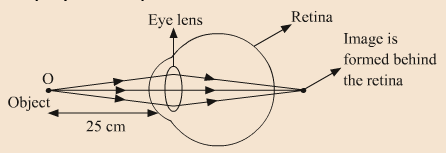
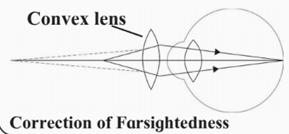
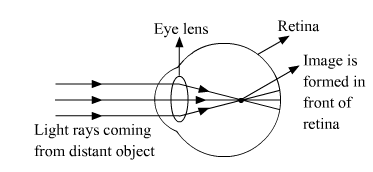

Question 2:
Draw a figure explaining various terms related to a lens.
Various Terms related with Lenses: 1) Optical centre : The point inside a lens on the principal axis, through which light rays pass without changing their path is called the optical centre (O) of the lens. 2) Centre of curvature : The centres of the spheres whose parts form the surfaces of a lens are called the centres of curvature of the lens. A lens has two centres of curvature C1 and C2 for its two spherical surfaces. 3) Radius of curvature : The distance of the optical centre from either of the centre of curvatures is termed as the radius of curvature. 4) Principal axis : The imaginary straight line joining the two centers of curvature and the optical centre (O) is called the principal axis of the lens. 5) Focus (Principal focus) (F) : When light rays parallel to the principal axis are incident on a convex lens, they converge at a point on the principal axis. This point is called the principal focus (F) of the convex lens. Light rays travelling parallel to the principal axis of a concave lens diverge after refraction in such a way that they appear to be coming out of a point on the principal axis. This point is called the principal focus of the concave lens. A lens has two principal foci F1 and F2. 6) Focal length : The distance between the focus (F1 or F2) and the optical centre (O) is known as the focal length of the lens.
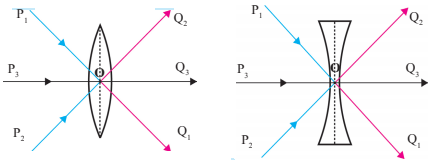
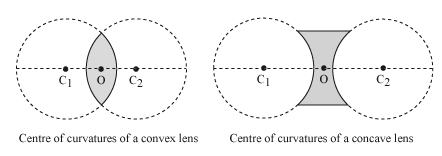

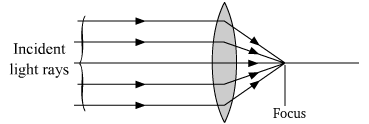
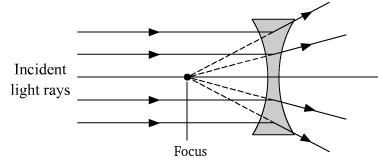

Question 3:
At which position will you keep an object in front of a convex lens so as to get a real image of the same size as the object? Draw a figure.
When an object is placed at the centre of curvature 2F1 of a convex lens, we will get a real image 2F2 of the same size as the object.
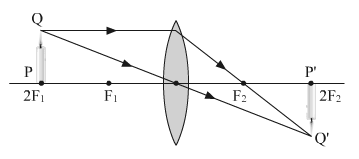
Question 4:
Give scientific reasons:
1. Simple microscope is used for watch repairs.
Hence, simple microscopes are used by watch makers to see the small parts and screws of the watch while repairing it.
2. One can sense colours only in bright light.
The cells present on the retina and responsible for colour vision are known as cone cells. These cells do not respond to faint light and function only under bright light. Thus, we are able sense only in bright light.
3. We cannot clearly see an object kept at a distance less than 25 cm from the eye.
We cannot clearly see an object kept at a distance less than 25 cm from the eye.
Question 5:
Explain the working of an astronomical telescope using refraction of light.
The astronomical telescope consists of two lenses: objective and eyepiece. Objective has larger focal length and diameter to accommodate maximum amount of light coming from the far away (astronomical) objects. Working :
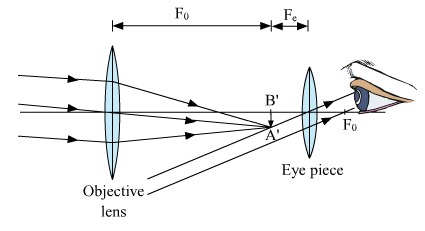 .
.
Question 6:
Distinguish between:
1. Farsightedness and Nearsightedness
Farsightedness (hypermetropia)
Nearsightedness (Myopia)
In hypermetropia, person clearly sees all the far away objects, but is unable to see the nearby objects comfortably and clearly.
In Myopia, person clearly sees all the nearby objects, but is unable to see the distant objects comfortably and clearly.
It is caused due to decrease in curvature of eye lens or decrease in length of eyeball.
It is caused due to increase in curvature of eye lens or increase in length of eyeball.
In this defect, image is formed behind the retina.
In this defect, image is formed in front of the retina.
It is corrected using convex lens.
It is corrected using concave lens.
2. Concave lens and Convex lens
Concave lens
Convex lens
It is a diverging lens because it diverges the rays falling on it.
It is a converging lens because it converges the rays falling on it.
It is thin at the center and bulged at the edge.
It is thin at the edge and bulged at the centre.
The image formed by concave lens is always diminished and virtual.
The image formed by convex lens can be real as well as virtual. Also, the image formed can be diminished as well as magnified.
It has a virtual focus.
It has a real focus.
Question 7:
What is the function of iris and the muscles connected to the lens in human eye?
Function of Iris: The iris is a muscular diaphragm that controls the size of the pupil, which, in turn, controls the amount of light entering the eye. It also gives colour to the eye. Function of ciliary muscles: The eye lens is held in position by the ciliary muscles. The focal length of the eye lens is adjusted by the expansion and contraction of the ciliary muscles.
Question 8:
Solve the following examples.
(1) Doctor has prescribed a lens having power +1.5 D. What will be the focal length of the lens? What is the type of the lens and what must be the defect of vision?
Given: Power of lens, P = +1.5 D, f=?
Now, focal length of lens, f=1/P =1/(+1.5D) =10/15 m =+0.67 m
P is positive, This shows the lens is convex. Thus, the defect of vision is farsightedness or hypermetropia.
(2) 5 cm high object is placed at a distance of 25 cm from a converging lens of focal length of 10 cm. Determine the position, size and type of the image.
Given: Height of object (h1) = 5 cm, Object distance (u) = −25 cm \(\frac{1}{f} = \frac{1}{v} - \frac{1}{u} ∴ \frac{1}{v} = \frac{1}{f} + \frac{1}{u}\) \(∴\frac{1}{v} = \frac{1}{10} + \frac{1}{-25} = \frac{1}{10} - \frac{1}{25}\) \(=\frac{3}{50} cm\) \(∴ \text{Image distance v} = \frac{50}{3}cm = 16.67 cm\) Thus, the image is formed 16.7 cm cm right of the lens. \(\frac{h_2}{h_1} = \frac{v}{u} ∴ h_2 = \frac{v}{u} h_1\) ∴ \(h_2 = \frac{v}{u} h_1\) ∴ \(h_2 = \frac{50/3}{-25} ×5 cm\) = \(-3.33 cm\) Thus, the size of the image is 3.3 cm. Negative sign shows that the image formed is real and inverted. Hence, the image formed is real and inverted and smaller than the object.
Focal length of the lens (f) = 10 cm
Using lens formula,
Now, we know
(3) Three lenses having power 2, 2.5 and 1.7 D are kept touching in a row. What is the total power of the lens combination?
Given: P1 = 2 D, P2 = 2.5 D, P3 = 1.7 D Let the total power of the lens combination be P. Thus, P=P1+P2+P3 = 2+2.5+1.7 =6.2 D
(4) An object kept 60 cm from a lens gives a virtual image 20 cm in front of the lens. What is the focal length of the lens? Is it a converging lens or diverging lens?
Given: f= ? \(\frac{1}{f} = \frac{1}{v} - \frac{1}{u} = \frac{1}{-20} - \frac{1}{-60}\) \(= -\frac{3-1}{60cm}\) \(= -\frac{1}{30cm}\) \(f=-30cm\) Since, the focal length is negative, the lens is a diverging lens.
Object distance, u = −60 cm
Image distance, v = −20 cm
Using lens formula,
Focal length = f, u= object distance, v=image distance, h1=height of object, h2=height of image
\(\frac{1}{f}=\frac{1}{v}-\frac{1}{u}\)
M= \( \frac{h_2}{h_1}=\frac{v}{u}\)
P= \(\frac{1}{f}\)
Combine Power P=P1+P2+.....
\(\frac{1}{f}=\frac{1}{f_1}+\frac{1}{f_2}\),,,,
Click on below link to get PDF from store
Class 10-Science & Technology-1-Chapter-7-Lenses -Notes
Class 10-Science & Technology-1-Chapter-7-Lenses - Solutions
Useful links :
| Main Page : - Maharashtra Board Class 10 Science & Technology Part-1,Part-2 - All chapters notes, solutions, videos, test, pdf.
Books : MSBSHSE -Class 10th Science Text Books – Chapter wise Text Book PDF of all chapter for download Videos : MSBSHSE Class 10th Science & Technology-1-Videos - Chapter wise Videos of all chapter. Previous Chapter : Chapter-6-Refraction of light - Online Solution Next Chapter : Chapter 8- Metallurgy -Online Solution |